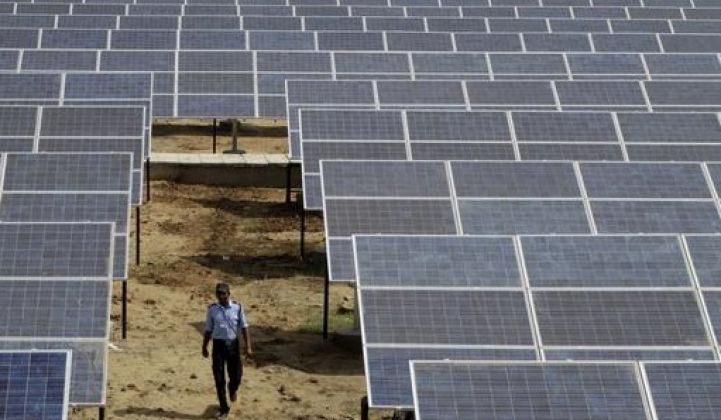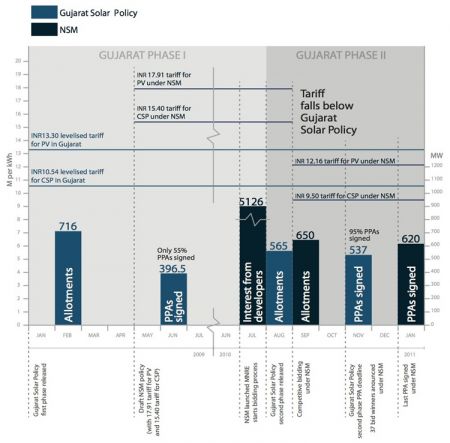This is the first piece in a series of articles that will offer insights and perspectives from GTM Research and BRIDGE TO INDIA's new report, The India Solar Market: Strategy, Players, and Opportunities. To learn more about the report, click here.
Solar power has so far played an almost nonexistent role in the Indian energy mix. The cumulative grid-connected photovoltaic (PV) capacity in India as of September 2011 stood at only 45 megawatts, less than any other national market with significant near-term promise.
However, GTM Research and Bridge to India forecast the market to grow significantly over the next 10 years, driven by rising power demand and fossil fuel prices; the ambitious Jawaharlal Nehru National Solar Mission; various state-level initiatives; renewable energy quotas, including solar energy quotas for utilities; and falling solar technology costs.
Encouraging the spread of solar power generation, both PV and concentrating solar power (CSP), and aiming for retail grid parity (currently at around INR5 per kilowatt-hour or $0.12 per kilowatt-hour) by 2022 and parity with coal generation by 2030 are both key elements in India’s comprehensive, long-term energy supply strategy. On average, the country has 300 sunny days per year and receives hourly radiation of 200 megawatts per square kilometer. However, as of July 2011, solar power generation in India cost around INR12 ($0.30) per kilowatt-hour for utility-scale systems, or more than three times as much as power from coal.
To achieve these solar development and cost reduction goals, two policies have come to the forefront of the market's early-stage evolution: The Jawaharlal Nehru National Solar Mission and the state of Gujarat's Solar Policy.
Jawaharlal Nehru National Solar Mission (NSM)
The NSM is the main instrument promoting solar demand in India. It targets installations of 20 gigawatts of grid-connected and 2 gigawatts of off-grid solar power by 2022.
In the policy's first of three phases, from 2010 to 2013, the government aims to set up 1,000 megawatts of grid- connected power plants. In addition, 200 megawatts of off-grid and 100 megawatts of small-grid solar power are to be installed at the tail end of the transmission grid.
For the financial year 2010-2011, the government originally offered a feed-in tariff of INR 17.91 ($0.44) per kilowatt-hour for utility-scale PV projects, rooftop projects, and projects migrated from previous incentive programs to the NSM (known as Migration Projects); a feed-in tariff of INR 15.40 ($0.38) was offered for CSP.
Power Purchase Agreements (PPAs) offered through the NSM have a tenure of 25 years. In June 2010, the Central Electricity Regulatory Commission (CERC) estimated that the tariff would allow investors an internal rate of return (IRR) on equity of about 16 percent to 21 percent after taxes. By September 18, 2010, the application deadline for projects under the first phase of the NSM, more than 400 project developers had put forward bids worth 1,815 megawatts for 150 megawatts of available PV and 3,311 megawatts for 500 megawatts of available CSP. The maximum size for a CSP bid was 100 megawatts; the maximum for a PV bid was 5 megawatts.
Given the oversubscription of the first round for projects, the government decided to award contracts based on competitive bidding to those project developers that offered the highest discount on the initial tariff of INR 17.91 ($0.44 per kilowatt-hour) for PV and INR 15.40 ($0.38 per kilowatt-hour) for CSP. Companies offering the highest discount to the tariff rate prescribed by the CERC were selected to produce 620 megawatt under the first phase. Thirty projects worth 150 megawatt for PV and seven projects worth 470 megawatt for CSP were selected.
For PV, the highest discount offered on the CERC tariff was INR 6.96 ($0.17 per kilowatt-hour) and the lowest successful discount was INR 5.15 ($0.12 per kilowatt-hour) per unit. Some of the successful bidders include well-known players such as SunEdison, Azure Power Rajasthan, Mahindra Solar One and IOC Ltd. However, most of the successful bidders were less well-known companies. The promoters behind these companies are often unknown, and some of the larger industrial houses were not awarded projects, as they did not bid aggressively enough.
For CSP projects, the highest discount offered was INR 4.82 ($0.12 per kilowatt-hour) per unit and the lowest was INR 3.07 ($0.07 per kilowatt-hour) per unit. The base feed-in tariff was INR 15.40 ($0.38 per kilowatt-hour) prior to accelerated depreciation.
Figure: Overview of First Round of NSM Bid Winners
Note: Click on above image to link to larger version of figure
Source: GTM Research
The Gujarat Solar Policy
The Gujarat solar policy was in place a year before the NSM was announced. It offers a levelized tariff of INR 13.30 ($0.33 per kilowatt-hour) for PV and INR 10.54 ($0.38 per kilowatt-hour) for CSP over 25 years.
There were no timelines or guarantees required from developers by the government to sign PPAs after the allotment of projects, although some companies like Moser Baer signed PPAs as early as January 12, 2009. Until late 2009, many developers had not signed PPAs in Gujarat. After the NSM policy was formalized in December 2009, developers moved away from Gujarat toward the NSM.
The tremendous interest from developers in the NSM led to competitive bidding for projects and a subsequent decrease in tariffs. The fall in the NSM tariff below the levelized tariff in Gujarat suddenly made the Gujarat policy very attractive to developers. Further, a significantly higher feed-in tariff in the first 12 years in Gujarat matches investors’ timelines, as they would look to cover the cost of debt during this period.
As compared to the NSM, the Gujarat policy has longer timelines for the execution of projects. At the same time, it has a stringent penalty mechanism for delays and intends to levy penalties on redundant projects. In addition, delayed projects will face a downward revision in their tariffs. An initial 48.5 megawatts of projects in the first phase were required to be commissioned by December 31, 2010. However, a 5-megawatt project by Lanco Infratech, a 5-megawatt project by Azure Power, and a 1-megawatt project by SunEdison were the only ones that have met their deadlines.
Figure: Gujarat (Phase I and II) vs. NSM Program (Phase I, Batch I) Event Timelines
Note: Click on above image to link to larger version of figure
Source: GTM Research
The first projects under the Gujarat program have already begun to come online. In October 2011, Moser Baer announced that it had completed a 30 MW project in the district of Banaskantha, the largest project to be completed yet in India. We anticipate at least another 150 megawatts will be completed before the end of 2011.
In addition to the NSM and Gujarat's Solar Policy, GTM Research and BRIDGE TO INDIA examine solar policy for Rajasthan, Karnataka, Tamil Nadu, Maharashtra, Orissa, Delhi and Andhra Pradesh. For more in-depth analysis, visit http://www.greentechmedia.com/research/report/the-india-solar-market-strategy-players-and-opportunities.





